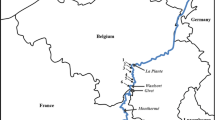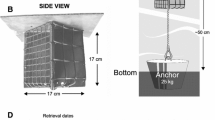Abstract
The colonization of artificially created aggregates of the mussel Mytilus edulis by organisms that inhabit an intertidal sand and mud flat was studied in a field experiment. The sediment of 40 experimental plots was cleared of macrofauna. Thirty of these plots were covered with fishing nets, on which either live mussels (ten plots, type M) or mussel dummies (ten plots, type D) were placed; on ten plots, the nets were left empty (type Z). The remaining ten plots without nets but with a cleared surface (type E) were the control. For comparison, samples were taken from the ambient intact community. After 16 days of exposure, the community on the plots differed from the ambient one. In the E-Z-D-M series, only 7 out of 29 taxa that were found in the samples differed significantly in abundance. Chironomid larvae, adults, and spat of M. edulis and Mya arenaria were most abundant on the plots with a hard substrate (Z, D, M). Adult Jaera sp., Oligochaeta, Littorina saxatilis, and Nemertea were more abundant on the type M plots. The abundance of spat of Macoma balthica and Hydrobia ulvae did not differ significantly. The results indicate that the biological activity of mussels M. edulis in dense assemblages facilitated immigration of adult animals of other species. The M. edulis aggregates either had no influence on the spat of mollusks or they attracted it as a hard substrate for settlement.
Similar content being viewed by others
References
Ivanov, M.V. and Chivilev, S.M., Emission, distribution, and utilization of organic substances during industrial mussel cultivation, in Materialy IV nauchn. seminara “Chteniya pamyati K.M. Deryugina” (Proc. 4th Sci. Seminar “Readings to the Memory of K.M. Deryugin”), St. Petersburg: Sanst-Peterb. Gos. Univ., 2002, pp. 98–114.
Lukanin, V.V., Naumov, A.D., and Fedyakov, V.V., On typical features of mussel biocoenoses in the White Sea, in Issledovaniya midii Belogo morya (Studies of Mussel in the White Sea), Leningrad: Zool. Inst., Akad. Nauk SSSR, 1985, pp. 59–69.
Sveshnikov, V.A., Biocoenotic relationships and living conditions for some forage invertebrates of infauna in the intertidal zone of Kandalaksha Bay, White Sea, Tr. Kandalaksh. gos. zapovednika (Works by Kandalaksha State Reserve), vol. 4, Tr. Belomor. biol. st. Mosk. Gos. Univ. (Works by the White Sea Biol. Station of the Moscow State University), Voronezh: Voronezh. Knizhn. Izd., 1963, vol. 2, pp. 113–134.
Khaitov, V.M. and Alekseeva, L.A., On the correlation between long-term dynamics of mussel beds and variations in the biomass of filamentous algae, Vestn. S.-Peterb. Univ., Ser. 3: Biol., 2005, no. 3, pp. 9–16.
Khaitov, V.M. and Artemyeva, A.V., On interactions between bivalves Mytilus edulis and gastropods Hydrobia ulvae in the intertidal zone of Dolgaya Inlet on Bolshoy Solovetsky Island (Onega Bay, White Sea), Vestn. S.-Peterb. Univ., Ser. 3: Biol. 2004, no. 4, pp. 35–41.
Khaitov, V.M., Artemyeva, A.V., Gornykh, A.Ye., et al., The role of mussel aggregates in structuring of communities on muddy-sand flats. Pt. 1. Composition of an aggregate-associated community in the intertidal zone of the White Sea, Vestn. S.-Peterb. Univ., Ser. 3: Biol., 2007, no. 4, pp. 3–12.
Khaitov, V.M., Artemyeva, A.V., Gornykh, A.Ye., et al., The role of mussel aggregates in structuring of communities on muddy-sand flats. Pt. 2. Formation of a community in experiment, Vestn. S.-Peterb. Univ., Ser. 3: Biol., 2007, no. 4, pp. 13–26.
Khaitov, V.M., Artemyeva, A.V., Fokin M.V., and Yakovis E.L., The structural and dynamic organization of consortia of Mytilus edulis aggregates in the intertidal zone of Dolgaya Inlet on Bolshoy Solovetsky Island. Pt. 2: The structure and dynamics of an aggregate-associated community, Vestn. S.-Peterb. Univ., Ser. 3: Biol., 2002, no. 4, pp. 18–29.
Khaitov, V.M., Gornykh, A.Ye., and Sarafannikova, T.E., The effect of mussels on growth of intertidal filamentous algae, Vestn. S.-Peterb. Univ., Ser. 3: Biol., 2008, no. 4, pp. 52–60.
Asmus, R. and Asmus, H., Mussel beds: limiting or promoting phytoplankton? J. Exp. Mar. Biol. Ecol., 1991, vol. 148, pp. 215–232.
Bayne, B., Primary and secondary settlement in Mytilus edulis, J. Animal Ecol., 1964, vol. 33, pp. 513–523.
Buschbaum, C., Dittmann, S., Hung, J.-S., et al., Mytilid mussels: global habitat engineers in coastal sediments, Helgol. Mar. Res., 2009, vol. 63, pp. 47–58.
Clarke, K.R. and Gorley, R.N., PRIMER v6: User Manual/Tutorial, Plymouth: PRIMER-E, 2006.
Commito, J.A. and Boncavage, E.M., Suspensionfeeders and coexisting infauna: an enhancement counterexample, J. Exp. Mar. Biol. Ecol., 1989, vol. 125, pp. 33–42.
Crooks, J.A. and Khim, H.S., Architectural vs. biological effects of a habitat-altering, exotic mussel, Musculista senhousia, J. Exp. Mar. Biol. Ecol., 1999, vol. 240, pp. 53–75.
Davenport, J., Smith R.J.J.W., and Packer, M., Mussels Mytilus edulis: significant consumers and destroyers of mesozooplankton, Mar. Ecol.: Progr. Ser., 2000, vol. 198, pp. 131–137.
Dittmann, S., Mussel beds-amensalism or amelioration for intertidal fauna? Helgoländ. Meeresunters., 1990, vol. 44, pp. 335–352.
Gutierrez, J.L., Jones, C.G., Stayer, D.L., and Iribarne, O.O., Mollusks as ecosystem engineers: the role of shell production in aquatic habitats, Oikos, 2003, vol. 101, pp. 79–90.
Hunt, H.L. and Sheibling, R.E., Spatial and temporal variability of patterns of colonization by mussels (Mytilus trossulus, M. edulis) on a wave-exposed rocky shore, Mar. Ecol.: Progr. Ser., 1998, vol. 167, pp. 155–169.
Ivanov, M.V., Smagina, D.S., Chivilev, S.M., and Kruglikov, O.E., Degradation and recovery of an Arctic benthic community under organic enrichment, Hydrobiologia, 2013, vol. 706, pp. 191–204.
Kautsky, N. and Evans, S., Role of biodeposition by Mytilus edulis in the circulation of matter and nutrients in a Baltic coastal ecosystem, Mar. Ecol.: Progr. Ser., 1987, vol. 38, pp. 201–212.
Kautsky, N. and Wallentinus, I., Nutrient release from a Baltic Mytilus-red algal community and its role in benthic and pelagic productivity, Ophelia, 1980, vol. 1, pp. 17–30.
Khaitov, V.M., Life in an unstable house: community dynamics in changing mussel beds, Hydrobiologia, 2013, vol. 706, pp. 139–158.
Koivisto, M. and Westerbom, M., Habitat structure and complexity as determinants of biodiversity in blue mussel beds on sublittoral rocky shores, Mar. Biol., 2010, vol. 157, pp. 1463–1474.
Koivisto, M., Westerbom, M., and Riihimaki, A., Succession-driven facilitation of macrofaunal communities in sublittoral blue mussel habitats, Mar. Biol., 2011, vol. 158, pp. 945–954.
Lehane, C. and Davenport, J., Ingestion of bivalve larvae by Mytilus edulis: experimental and field demonstrations of larviphagy in farmed blue mussels, Mar. Biol., 2004, vol. 145, pp. 101–107.
McGrath, D., King, P.A., and Gosling, E.M., Evidence for the direct settlement of Mytilus edulis larvae on adult mussel beds, Mar. Ecol.: Progr. Ser., 1988, vol. 47, pp. 103–106.
Norkko, J., Bonsdorff, E., and Norkko, A., Drifting algal mats as an alternative habitat for benthic invertebrates: species specific responses to a transient resource, J. Exp. Mar. Biol. Ecol., 2000, vol. 248, pp. 79–104.
Pfister, C., Intertidal invertebrates locally enchance primary production, Ecology, 2007, vol. 88, pp. 1647–1653.
Pfister, C., Meyer, F., and Antonopoulos, D.A., Metagenomic profiling of a microbial assemblage associated with the California mussel: a node in networks of carbon and nitrogen cycling, PLoS One, 2010, vol. 5, p. e10518.
StatSoft. Statistica for Windows. Computer program manual, Tulsa: StatSoft, 1994.
Author information
Authors and Affiliations
Corresponding author
Additional information
Original Russian Text © V.M. Khaitov, J.B. Brovkina, 2014, published in Biologiya Morya.
Rights and permissions
About this article
Cite this article
Khaitov, V.M., Brovkina, J.B. Mechanisms used by the inhabitants of a sand flat in the White Sea to colonize aggregates of Mytilus edulis Linnaeus, 1758 (Bivalvia: Mytilidae). Russ J Mar Biol 40, 295–302 (2014). https://doi.org/10.1134/S1063074014040117
Received:
Published:
Issue Date:
DOI: https://doi.org/10.1134/S1063074014040117




